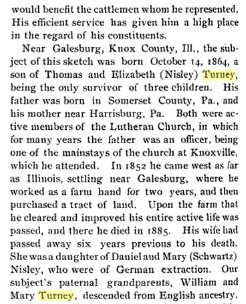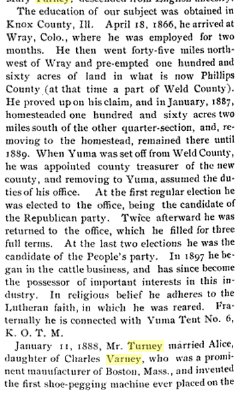Yuma County, Colorado
Photographs

Yuma County, Colorado |
 |
| Home Page | Photograph Index | Site Index |
 \
\





August 19, 1937 
March 15, 1951 
July 19, 1918 "Mr. and Mrs. Roland Colwell, who spent two weeks at the P. O. Colwell and A. N. Turney homes,
returned yesterday to their home in Scottsbluff, Neb. They were accompanied home by Mrs. Colwell's sister. Miss Beth Turney, who will visit there for some time."
1936 Windsor, Colorado items in the Greeley newspaper "Thanksgiving Day dinners wore given by Windsor residents,
some of which, are no follows: "Mr. and Mrs. R. L. Colwell entertained that day Mr. and Mildred, Mrs. A. N. Turney,
Mrs. Mary Colwell, Ruth Colwell, all of Loveland, and Tom Colwell of Greeley. Their son, Kenneth Colwell, who went to
Denver with the Colorado university band, did not get home in time for the dinner, but will spend the week end here."
1938 " Dinners honoring mother on Mother's day were given in many of the homes in Windsor and community Sunday.
Mr. and Mrs; R. L. Colwell entertained at their home that day, Mrs. Mary Colwell of Loveland, her daughter,
Miss Ruth Colwell, and Mrs. Colwell's mother, Mrs. A. N. Turney."
Alice B. (Bunker) Turney 1860-1951 is buried in Loveland # 37465514.
Edith Turney married Marvin Morgan on August 20, 1914, recorded in Weld County.
March 10, 1920 "Mr. and Mrs. M.J. Morgan of Trinidad are the proud parents of a baby girl,
Eldora Grace, born Thursday March 4th. Mrs. Morgan will be remembered as Miss Edith Turney.
Linton L. Walker married Beth Turney in Loveland December 27, 1925.
Beth Walker is in Denver in 1930, married
to Linton Walker 37, a car salesman, with John A. 1.
Beth 1900-1938 is buried in Loveland, with Lenton L. 1892-1944
Original Yuma Pioneers: Albert and Alice Turney By MATT VINCENT Thousands of settlers followed the path of the Chicago, Burlington & Quincy Railroad into northeastern Colorado in the early 1880s, seeking fertile ground, greener pastures and a place to put down roots. It was by definition a mass migration. Between 1880 and 1890, the state's population more than doubled, rising from roughly 200,000 residents to more than 423,000. Within 20 years it doubled again. Lured by the promise of cheap land in what was billed as the state's "rain belt," immigrants came from across the eastern U.S. and from many foreign counties, chiefly Germany, England, Sweden, Russia and Italy. By 1910 an estimated 17 percent of Colorado's population was rural and foreign-born. As this wave of homesteaders flooded the eastern plains, communities popped up like weeds in fresh-plowed ground. To better serve the growing population, to issue legal documents, to collect taxes, to provide contracts, the state had to expand local government. In northeastern Colorado the effort began with the creation of Washington County, using portions of previously established Weld and Arapahoe counties. The small railroad town of Akron became its county seat in 1887. Before the ink had dried on a new state map, however, officials in Denver realized Washington County was not enough - at least not for residents in distant communities like Yuma, Eckley, Wray, Waverly and Vernon. Two years later under the administration of Colorado Gov. Job Adams Cooper, 13 more counties were added, which is how Yuma, Morgan, Sedgwick, Phillips, Kit Carson and other counties were put on the map. To run a government required qualified manpower so temporary appointments were made until elections were in November. For Yuma County and its new county seat in Yuma, Cooper appointed three commissioners (W.R. Field, James S. Hendrie and A.M. Bullard), a county clerk (George F. Weed) and a county treasurer (Albert N. Turney), along with a handful of other pioneers to fill vacancies for county judge, assessor, surveyor, school superintendent and coroner. The first Yuma County Clerk, George Weed and his wife, Ida, are credited for the homestead claims and original platting of Yuma. We don't know a whole lot about the other Yuma pioneers, though. In the case of Turney, that's very unfortunate because he alone may have had the greatest impact on the future of Yuma and other small communities across northeastern Colorado. Albert Nisley Turney was born in 1864 near Galesburg, Ill., and received his education at Knox College, the same institution, ironically, attended by Gov. Cooper prior to the Civil War. In the summer of 1886 at the age of 22, Albert stepped off a westbound train in Wray and began looking for work. With his drive, determination and ambition, he found employment quickly. Within a few months he had saved enough money to file a claim on 160 acres of ground in nearby Phillips County. In January of 1888 he married Alice Varney in Wray and the newlyweds quickly added an adjacent quarter to their holdings. Two decades later Albert and Alice were said to have one of the finest cattle herds in northeastern Colorado. The young couple moved to Yuma in 1889 where Albert accepted the governor's appointment to become Yuma County's first treasurer and recorder. His friends and neighbors kept him in office for three more terms during a critical time when the region was booming. It was during this time that his reputation for honesty and integrity became known. In 1897 Albert announced that he was stepping down from public office to pursue other interests. But community leaders encouraged him to run for higher office. With some reluctance he agreed, winning the State Representative seat and becoming the first - but certainly not the last - politician from Yuma. Contemporaries claimed he was the best lawmaker to ever represent the eastern plains, an opinion that was clearly supported by area newspapers. "Even those who do not agree politically with Mr. Turney speak in the most generous manner of his abilities and character," wrote the editor of the Fort Morgan Times at the turn of the 19th Century. Added the Brush Mirror in 1899: "He is a man of good business and executive abilities and unquestionable integrity and universally respected by those who know him." Throughout the homestead era, farmers and ranchers had grown weary of being treated like second-class citizens by Front Range lawmakers. Albert fought for change during the 12th General Assembly and became an advocate for rural residents and his constituency. His most important contribution may have been one that we take for granted today. During his short tenure in the General Assembly, Turney crafted and introduced what became known as the "The Road Bill." It was signed into law in May of 1899, paving the way for the construction of an improved wagon road from the eastern border of Colorado near the North Fork of the Republican to the South Platte near Fort Morgan, a commercial venture that would connect rural communities and commerce for years to come. Turney's Road followed the old CB&Q railroad and years later would become U.S. Highway 34. And to borrow a popular phrase coined by the late Paul Harvey: "And now you know the rest of the story." Much to the dismay of local residents, Albert and Alice left Yuma in 1900. They moved to the Loveland area where they eventually got involved in the booming tourism industry in the foothills and mountains to the west. Albert died in 1927. Alice passed away in 1951 at the age of 91. Both are buried in the Loveland Cemetery. 

|
This page is maintained by M.D. Monk.